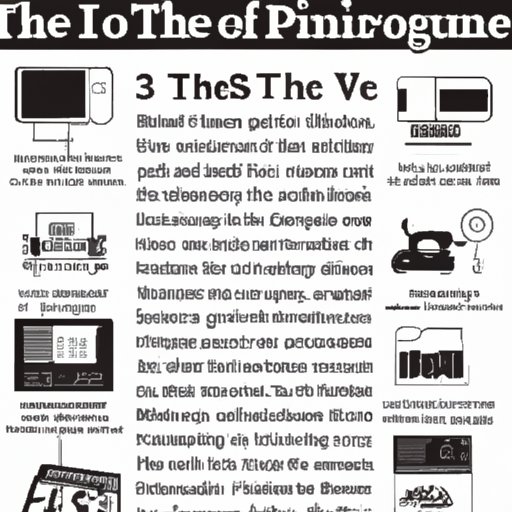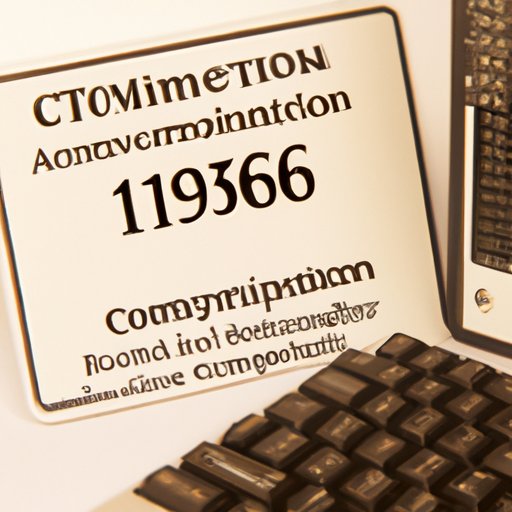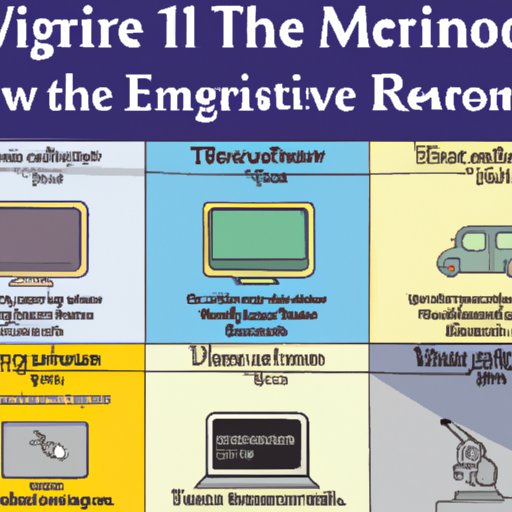Introduction
A computer is an electronic device that can receive, store, process, and output data. Today, computers are incredibly powerful and versatile, used for a wide range of activities such as work, entertainment, communication, and more. But when was the computer first invented? To answer this question, it’s important to understand the historical timeline of computing devices and the major milestones that led to the invention of the computer.

Historical Overview: A Timeline of When the Computer Was Invented
The concept of computers dates back centuries, with early computing devices such as the abacus being used as far back as 2000 BC. However, the modern computer as we know it today has a much more recent history. Here is a timeline of some of the major milestones in the development of computers:
Early Computing Devices
In the 17th century, mechanical calculators were developed to help with mathematical equations. These devices used gears and levers to add, subtract, multiply, and divide numbers. The Jacquard loom, which was invented in 1801, was one of the earliest examples of a programmable machine. It used punched cards to control the patterns woven into fabric.
Charles Babbage and the Analytical Engine
In the 19th century, English mathematician Charles Babbage designed the Analytical Engine, which is considered to be the first modern computer. This device was capable of carrying out complex calculations, and it included features such as memory storage and conditional branching. Although Babbage never completed the engine, his design laid the groundwork for future computers.
Konrad Zuse and the Z3 Computer
In 1941, German engineer Konrad Zuse built the world’s first working programmable, fully automatic digital computer. The Z3 computer was able to perform basic arithmetic operations and had a storage capacity of 64 words. It was a significant milestone in the development of computers.
John Mauchly and J. Presper Eckert and ENIAC
In 1945, American scientists John Mauchly and J. Presper Eckert developed the Electronic Numerical Integrator and Computer (ENIAC), a large-scale general purpose computer. This machine was the first to use vacuum tubes for circuitry and could calculate 5,000 operations per second. ENIAC ushered in the era of modern computing.
John von Neumann and EDVAC
In 1946, Hungarian-American mathematician John von Neumann proposed the idea of a stored-program computer, which would be able to both store and execute instructions. This concept was implemented in the Electronic Discrete Variable Automatic Computer (EDVAC) in 1951. EDVAC was the first computer to use the von Neumann architecture, which is still the basis for most modern computers.
Transistor Computers
In 1947, Bell Laboratories developed the transistor, which replaced the bulky and unreliable vacuum tubes used in earlier computers. Transistors allowed computers to become smaller, faster, and more reliable. In 1958, the first commercial transistor computer, the IBM 7090, was released.
Personal Computers
In 1975, the Altair 8800 became the first commercially successful personal computer. This machine was powered by an Intel 8080 microprocessor and featured a keyboard and a monitor. Since then, computers have become increasingly powerful and ubiquitous, with nearly every household owning at least one.
Exploring Key Figures Involved in the Creation of the Computer
One of the most important figures in the history of computers is Charles Babbage. His Analytical Engine was the first machine to incorporate many of the features found in modern computers. Without his pioneering work, computers as we know them today may not exist.
Another important figure in the history of computers is Konrad Zuse. He developed the world’s first programmable, fully automatic digital computer. His work was a major milestone in the development of computers.
Two other important figures in the history of computers are John Mauchly and J. Presper Eckert, who developed the first large-scale general purpose computer, ENIAC. Their work paved the way for the development of modern computers.
Finally, John von Neumann is another important figure in the history of computers. His proposal for a stored-program computer revolutionized the field of computer science and is still the basis for most modern computers.

Examining the Major Milestones Along the Way to the Invention of the Computer
As mentioned earlier, there have been many milestones in the development of computers. From the early computing devices of the 17th century to the modern computers of today, here is a closer look at some of the major milestones along the way:
Early Computing Devices
The abacus and other mechanical calculators were some of the earliest computing devices, used mainly for mathematical calculations. The Jacquard loom, invented in 1801, was one of the first programmable machines.
Analytical Engine
Charles Babbage’s Analytical Engine was the first machine to incorporate many features found in modern computers. Unfortunately, it was never completed due to financial constraints.
Z3 Computer
In 1941, Konrad Zuse developed the world’s first programmable, fully automatic digital computer. This machine was capable of performing basic arithmetic operations and had a storage capacity of 64 words.
ENIAC
John Mauchly and J. Presper Eckert developed the Electronic Numerical Integrator and Computer (ENIAC) in 1945. This machine was the first to use vacuum tubes for circuitry and could calculate 5,000 operations per second.
EDVAC
John von Neumann proposed the idea of a stored-program computer, which was implemented in the Electronic Discrete Variable Automatic Computer (EDVAC) in 1951. This machine was the first to use the von Neumann architecture.
Transistor Computers
In 1947, Bell Laboratories developed the transistor, which replaced the bulky and unreliable vacuum tubes used in earlier computers. This allowed for the development of smaller, faster, and more reliable computers.
Personal Computers
In 1975, the Altair 8800 became the first commercially successful personal computer. This machine was powered by an Intel 8080 microprocessor and featured a keyboard and a monitor.
The Impact of the Computer on Society and Culture
Since their invention, computers have had a tremendous impact on society and culture. They have increased efficiency in many areas, from business to education, and have improved communication by making it easier to connect with people around the world. Computers have also enabled automation, which has allowed us to do more with less effort. Furthermore, computers have enabled us to access vast amounts of information quickly and easily. Finally, computers have allowed us to stay connected through social media platforms and other online services.

How Computers Have Evolved Over Time
Over the years, computers have become faster, more powerful, and more versatile. One of the biggest changes has been the increase in processing power. This has allowed computers to handle more complex tasks and applications. Cloud computing has also become increasingly popular, allowing users to access data and applications from remote servers. Artificial intelligence is another area of growth, with computers becoming smarter and more capable of handling complex tasks. Finally, miniaturization has allowed computers to become smaller and more portable.
Conclusion
The invention of the computer has revolutionized our lives in many ways, from increased efficiency to improved communication. By examining the historical timeline of computing devices and the major milestones that led to the invention of the computer, we can gain a better understanding of the key figures involved in its creation and the impact it has had on society and culture. Furthermore, we can see how computers have evolved over time, becoming faster, more powerful, and more versatile.
(Note: Is this article not meeting your expectations? Do you have knowledge or insights to share? Unlock new opportunities and expand your reach by joining our authors team. Click Registration to join us and share your expertise with our readers.)
